
Microaggressions/Macroaggressions/Microinequity/Microinsults
Everyday Indignities: Microaggressions, Microassaults, Microinsults, Microinvalidation, Microinequities, and Macroaggressions
Author(s): Tara Overbeeke, MD
Definition(s) of Terms
Starting with a common understanding of key words, phrases, and potentially misunderstood related terms in DEI discussions helps ensure that all participants feel informed and welcome to participate in the discussion. Some terms have multiple definitions provided to help highlight nuances in the definitions.
Microaggression: Brief and commonplace daily verbal, behavioral, and environmental indignities, whether intentional or unintentional, that communicate hostile, derogatory, or negative slights and insults to the target person or group (1)
Examples include:
- Asking an African American “Where were you born?”
- Commenting to an Asian American “You are so articulate.”
- Stating “I’m not racist. I have several Black friends.”
- Mistaking a person of color for a service worker
Environmental microaggression: When microassualts, microinsults, and microinvalidations are reflected in culture, processes, and climate of the workplace (1)
- Examples: A college or university with buildings that are are named after white males, television shows and movies that feature predominantly white people, overcrowding of public schools in communities of color
Microassault
- Definition: Explicit derogation characterized primarily by a verbal or nonverbal attack meant to hurt the intended victim through name-calling, avoidant behavior, or purposeful discriminatory actions (1)
- Examples: displaying a swastika, discouraging interracial interactions, using racial epithets
Microinsult
- Definition: Communications that convey rudeness and insensitivity and demean a person’s racial heritage or identity (1)
- Example: African American is asked “How did you get your job?” implying position was obtained through affirmative action or quota program
Microinvalidation
- Definition: Communications that exclude, negate, or nullify the psychological thoughts, feelings, or experiential reality (1)
- Example: Asian American individual who was born and raised in the US is complimented for speaking good English
Microinequity: the pattern of being overlooked, under-respected, and devalued because of one’s race or gender (1)
Macroaggression
- Definition: Big, systemic forms of oppression rather than interpersonal forms of bias or discrimination (2)
- Example: Corporations taking advantage of impoverished populations
Racial macroaggression: systemic and institutional forms of racism that is manifested in the philosophy, programs, policies, practices and structures of governmental agencies, legal and judicial systems, health care organizations, educational institutions, and business and industry (3)
- Affect whole groups or classes of people
Microinequity: small events which are often ephemeral and hard-to-prove, events which are covert, often unintentional, frequently unrecognized by the perpetrator (4)
Healthcare microaggressions: implicit discrimination within the healthcare setting, whereby treatment providers who are in positions of authority inadvertently marginalize members of minority groups through culturally insensitive interactions (5)
Corporeal microaggressions: the imposed values and potentially hostile treatment and degrading comments made by physicians towards marginalized, pregnant women (6)
Microinterventions: everyday words or deeds, whether intentional or unintentional, that communicates to targets of microaggressions (a) validation of their experiential reality, (b) value as a person, (c) affirmation of their racial or group identity, (d) support and encouragement, and (e) reassurance that they are not alone. (3)
Gaslighting: the act of manipulating others to doubt themselves or question their own sanity (7)
Synonyms/Related Terms
This section highlights the definitions of other words that may be used in discussion of this topic. Sometimes these words can be used interchangeably with the terms defined above, and sometimes they may have been used interchangeably historically, but have distinct meanings in DEI conversations that it is helpful to recognize.
For microaggression: subtle prejudice
For racial microaggression: subtle racism, covert racism
Scaling This Resource: Recommended Use
As many users may have varying amounts of time to present this material, the authors have recommended which resources they would use with different timeframes for the presentation.
1-minute presentation: define types of microaggressions
10-minute presentation: define types of microaggressions, discuss approach to addressing microaggression, discuss example using Georgetown University School of Medicine: Microaggressions in Medicine Flyer Gallery
30-minute session: Prior to session view powerpoint from Addressing Microaggressions in Academic Health: A Workshop for Inclusive Excellence (https://www.mededportal.org/doi/10.15766/mep_2374-8265.11103)40
- Discuss approach to addressing microaggression
- Role play 1-2 scenarios in small group
- Reconvene with whole group to debrief and reflect
60-minute session (30-minute presentation and 30-minute small group):
- Presentation: define types of microaggressions, discuss approach to addressing microaggressions
- Small group: role play 1-2 scenarios or 1-2 discussion questions, reconvene with whole group to debrief and reflect
Discussion/Background
This section provides an overview of this topic so that an educator who is not deeply familiar with it can understand the basic concepts in enough detail to introduce and facilitate a discussion on the topic. This introduction covers the importance of this topic as well as relevant historical background.
The term “microaggression” was first coined by Dr. Chester Pierce an African American psychiatrist in the 1970s who described microaggressions as “black-white racial interactions [that] are characterized by white put-downs, done in an automatic, preconscious, or unconscious fashion.” (8) The prefix “micro” was used because the acts are commonplace in everyday interactions and not because the acts are insignificant. This concept was further popularized by Dr. Derald Wing Sue in 2007. He described racial microaggressions as “brief and commonplace daily verbal, behavioral, and environmental indignities, whether intentional or unintentional, that communicate hostile, derogatory, or negative racial slights and insults to the target person or group.” (1)
Dr. Sue described three forms of microaggressions: microassault, microinsult, and microinvalidation (see Figure 1). Microassualts are defined as “old fashioned racism” that consists of verbal or nonverbal attacks intended to cause harm to the victim through derogatory names, avoidant behavior, and discriminatory actions. Examples of microassaults include using racial epithets or displaying a confederate flag. Microinsults are described as communications that confer disrespect and insensitivity that demean a person’s ethnicity or heritage. An example of microinsults is when a white employer tells a person of color applicant, “I believe the most qualified person should get the job, regardless of race.” This implies that people of color are given extra benefits due to their race. Microinvalidations are communications that exclude or negate thoughts, emotions, or experiential reality. An example of a microinvalidation is when an Asian American who was born and raised in America is told that they speak English well. This can make an individual feel like an outsider in their own country. (1) As societal awareness of other marginalized groups grew, the concept of microaggressions was subsequently expanded to also include gender and sexual orientation. (9)
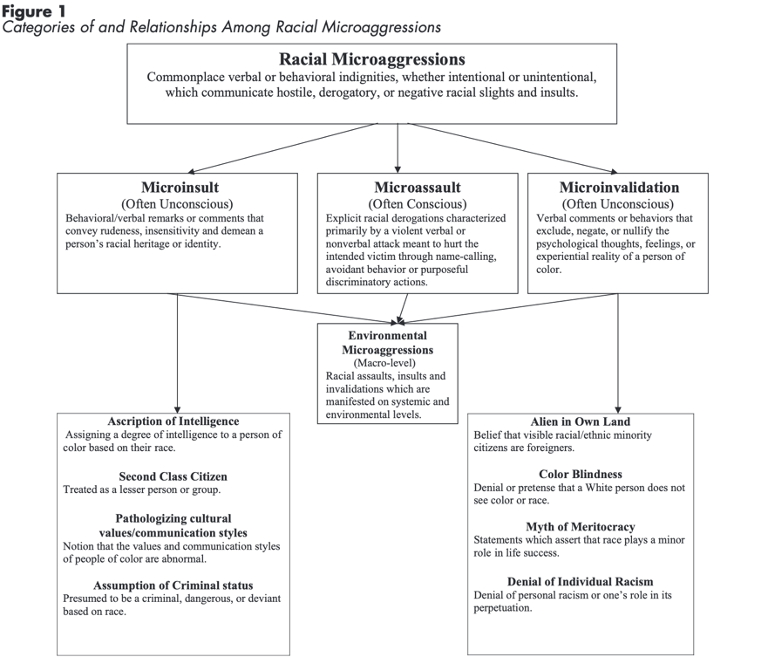
From Sue 2007.
In contrast to microaggressions, macroaggressions often occur at a systemic level but continue to have an impact on an individual level. Macroaggressions have been described as “big, systemic forms of oppression rather than interpersonal forms of bias or discrimination.” (2) Macroaggressions can permeate many aspects of society including governmental policies/programs, judicial system, educational institutions, health care organizations, and business. (3)
Healthcare microaggressions have been defined as implicit discrimination where treatment providers inadvertently marginalize members of minority groups. (5) Research related to microaggressions in the context of medical treatment is limited. In one study, the concept of corporeal microaggressions was identified which is described as “the imposed values and potentially hostile treatment and degrading comments made by physicians towards marginalized, pregnant women.” (6) Repeated microaggressions are likely additive and may lead to barriers in adequate patient care and health disparities.
Microaggressions toward physicians are a common yet frequently underreported occurrence. In fact, 72% of surveyed surgical residents reported experiencing microaggressions in the workplace, but only 7% reported these incidents to their graduate medical education office or program director. (10) Non-white and female physicians have been shown to experience a disproportionate frequency of microaggressions, (11,12) and non-white female physicians experience a cumulative effect. (12) Common types of gender-based microaggressions in medicine include: sexism, pregnancy and childcare bias, having abilities underestimated, sexually inappropriate comments, being relegated to mundane tasks, and feeling excluded/marginalized. (13) Specific to emergency medicine, microaggressions are commonplace in the emergency department. 65% of surveyed medical providers in the emergency department reported experiencing microaggressions with misidentification being the most common form followed by derogatory comments by patients. (14)
Microaggressions directed toward medical providers cause more than simply personal frustration. Repeated experiences have been linked to depression, anxiety, burnout, and even suicidal ideations. (15,16) Physician depression and burnout have in turn been associated with suboptimal patient care and medication errors. (17) The following figure from Feaster 2021 includes example scenarios of microaggressions in medicine along with their associated consequences. (18)
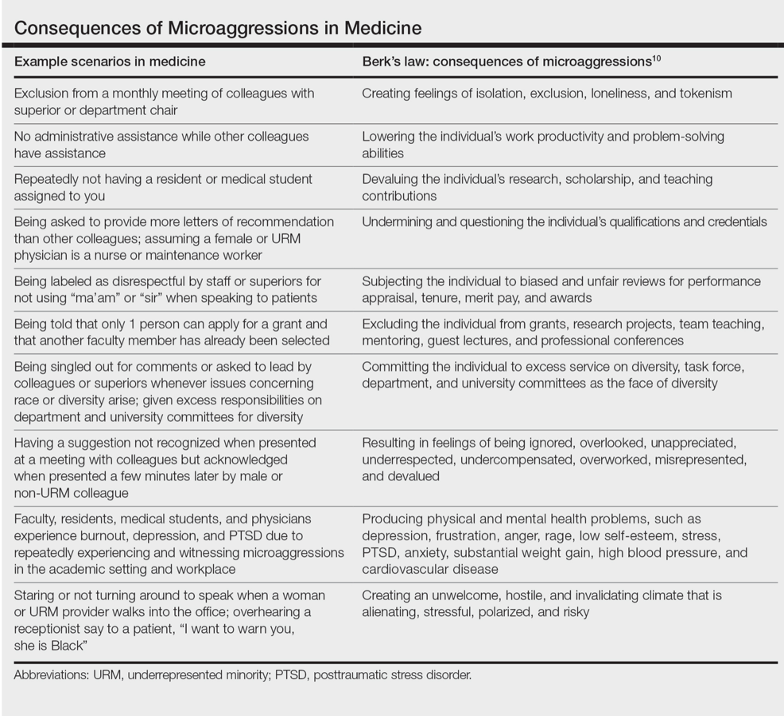
Figure from Feaster 2021
Multiple communication strategies have been proposed for how to respond to microaggressions. The term “microinterventions” has been used to describe any of the approaches that have the goal to counteract or stop the microaggressions by confronting and/or educating the offender. The four main goals of the strategies include: make the “invisible” visible, disarm the microaggression, educate the offender, and seek external intervention. (3)
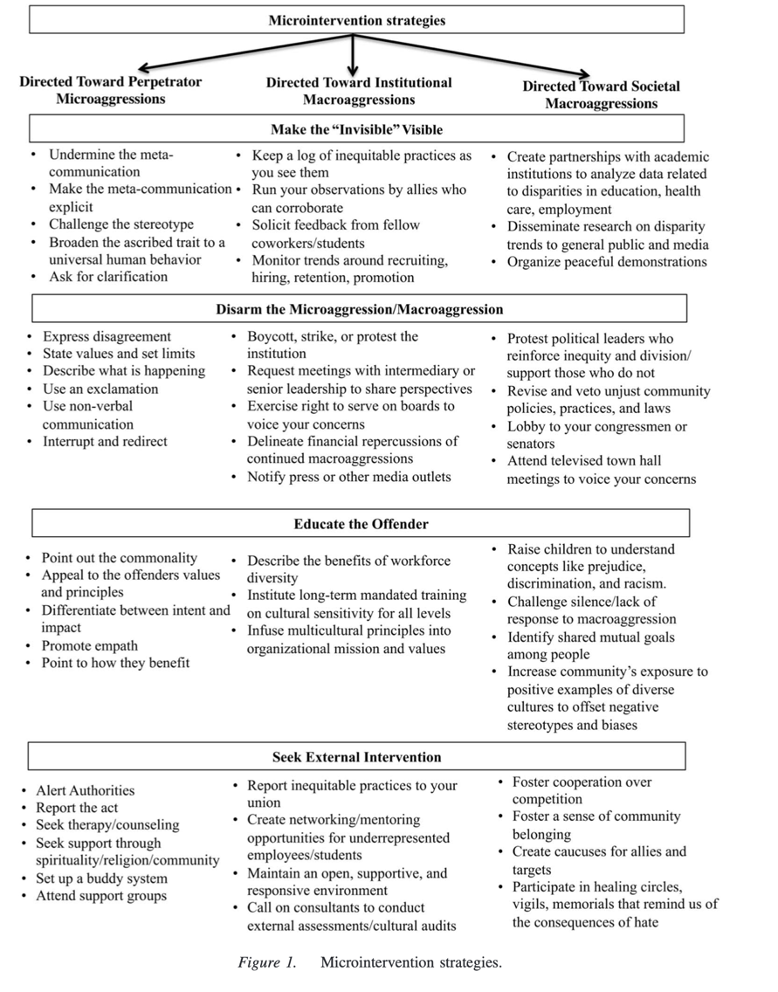
Figure from Sue 2019
Proposed frameworks include:
“Open the Front Door” (Observe, Think, Feel, Desire) This approach encourages open communication that allows an individual to handle conflict without the other party becoming defensive. An example response could include, “When you said (microaggression), it made me think that you (negative opinion). I feel concerned about this because (reason), and I would like us to discuss this further so we can come to an understanding.” (15,19)
The ACTION framework (20)
- Ask clarifying questions
- Come from curiosity, not judgment
- Tell what you observed in a factual manner
- Impact exploration—discuss what the impact of the statement was
- Own your own thoughts and feelings
- Next steps
The RAVEN Approach (21)
- Redirect the interaction
- Ask probing questions
- Values clarification
- Emphasizing your own thoughts
- Next steps
XYZ Approach15
- I feel X when Y because Z.
Quantitative Analysis/Statistics of note
This section highlights the objective data available for this topic, which can be helpful to include to balance qualitative or persuasive analysis or to help define a starting point for discussion.
- Over half of medical students at a US medical school reported experiencing microaggressions during their medical education. (22)
- 72% of surgical residents reported experiencing microaggressions yet only 7% reported events to graduate medical education office/program director. (10)
- 65% of surveyed medical providers in emergency department reported experiencing microaggressions. Female and non-white respondents were more likely to report experiencing microaggression. (14)
Slide Presentation or Images
Images and graphical representations in presentations can clarify concepts and enhance interest. Please cite the sources of these images appropriately if you use them in your presentation, found in the last section of this page. We purposefully avoided providing complete slide decks in this curriculum, and instead opted to offer easy building blocks for a great personalized presentation regardless of the format.
Images:
Georgetown University School of Medicine: Microaggressions in Medicine Flyer Gallery (https://som.georgetown.edu/diversityequityandinclusion/odi-initiatives/microaggressions/): Website with flyers highlighting examples of microaggressions and the A.C.T.I.O.N. approach to responding to microaggressions (23)
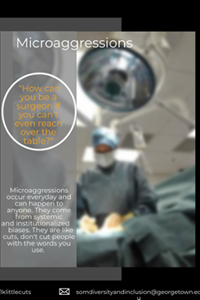 | 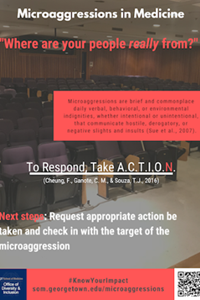 | 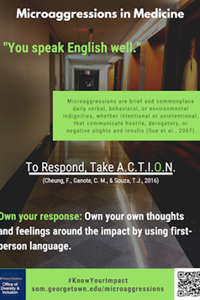 | 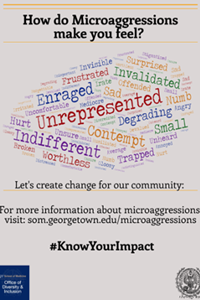 |
University of Toledo College of Medicine and Life Sciences (https://www.utoledo.edu/med/events/images/UTCOMLS-Diversity-Microagressions-2021.jpg): Graphic that highlights the definition of microaggression (24)

Slide presentation:
The Impact of Microaggressions—An Introductory Training (https://cehs.unl.edu/images/EdPsych/nicpp/NICPP_microaggression_presentation_2015-06-02.pdf): Powerpoint presentation prepared by Dr. Brea Banks for the Nebraska Internship Consortium in Professional Psychology that describes microaggressions and how to respond. (25)
Role-playing Scenario
Role-playing scenarios can enhance investment and participation. Always consider psychological safety when asking participants to engage in any role-playing activity to avoid potential adverse effects. We highly recommend a discussion for each group to agree on ground rules of respectful learning prior to engaging in any role-playing scenarios (embrace ambiguity, commit to learning together, listen actively, create a brave space, suspend judgment, etc.). It is reasonable to review these ground rules prior to each role-playing discussion.
Prepare learners
- Define microaggressions and terms related to topic
- Provide examples of microaggressions
- Discuss a method to respond to microaggressions
Role Playing Scenario #1
Today is Dr. Jennifer Wu’s first shift as an emergency medicine (EM) intern in the emergency department. Her team consists of an EM attending, third year EM resident, and herself. Her attending Dr. Smith asks each member of the team to introduce themselves and share where they are from. Dr. Wu tells them her name and states that she is from Jackson, Mississippi. Dr. Smith says, “You don’t sound like you are from Mississippi. Where are you originally from?”
Assign roles:
- Divide into groups of two
- Assign the roles of Dr. Wu and Dr. Smith
Run the role play for 5-10 minutes
Debrief:
- As Dr. Wu, how did you feel about the interaction?
- As Dr. Smith, how did you feel about the interaction?
- What are some other ways to respond to this situation?
- How would you respond if you were a third year EM resident witnessing this interaction?
- How would you respond if you were a fourth year medical student witnessing this interaction?
Role Playing Scenario #2
Dr. Ashley Jones is a third year EM resident working a shift in the emergency department. She signs up to see Mr. Miller, a 40-year-old male who is presenting with chest pain. Dr. Jones introduces herself to the patient stating “My name is Dr. Jones. I am the emergency medicine resident physician who will be taking care of you today. What brings you to the emergency department?” After completing her history and physical, Dr. Jones tells Mr. Miller, “I will order some tests as well as aspirin for your pain. I will come back in 15 minutes to reevaluate your pain.” Fifteen minutes later, Dr. Jones enters Mr. Miller’s room. He is on the phone and says to the person on the phone, “Hold on. The nurse is here.”
Assign roles:
- Divide into groups of two
- Assign the roles of Dr. Jones and the patient, Mr. Miller
Run the role play for 5-10 minutes
Debrief:
- What are some ways to respond to this situation?
- How would you respond if you were the EM nurse witnessing this interaction?
Barriers/Challenges/Controversies
This section should help the facilitator anticipate any questions, naysayers, rebuttals, or other feedback they may encounter when presenting the topic and allow preparation with thoughtful responses. Facilitators may experience concerns about their personal ability to present a specific DEI topic (ie a white facilitator presenting on anti-racism or minority tax), and this section may address some of those tensions.
Controversy:
Some have voiced criticism of the concept of microaggressions arguing that the definition is too fluid and the interpretation is subjective which makes it difficult to study. What may be perceived as a microaggression to one person may be perceived differently by another. At times, it is unclear to both the perpetrator and the victim if a microaggression has occurred. Many publications examining microaggressions and mental health have been case studies. Further research has been suggested to delineate true connections between microaggressions and mental health. (26)
Ethical Issues
This section may be useful to hospital ethics committees who want to increase their DEI awareness as part of monthly meetings, or to other groups who are interested in the ethical underpinnings of the topic.
Unconscious mistreatment of others, perpetuation of negative societal perceptions.
Opportunities
Sometimes DEI topics can present depressing history and statistics. This section highlights glimmers of hope for the future: exciting projects, areas of study inspired by the topic, or even ironic twists where progress has emerged or may be anticipated in the future.
With increased awareness of implicit bias and microaggressions in medicine, more academic institutions and employers are encouraging implicit bias/microaggression training for trainees and employees. These workshops can improve an individual’s ability to identify microaggressions and can increase confidence in responding to microaggressions. After one such workshop, 97% of participants agreed that the workshop was a worthwhile use of their time. (27)
Journal Club Article links
A journal club facilitator can access several salient publications on this topic below. Alternatively, an article can be distributed ahead of a presentation to prompt discussion or to provide a common background of understanding. Descriptions and links to articles are provided.
Molina MF, Landry AI, Chary AN, Burnett-Bowie SM. Addressing the Elephant in the Room: Microaggressions in Medicine. Ann Emerg Med. 2020 Oct;76(4):387-391. doi: 10.1016/j.annemergmed.2020.04.009. Epub 2020 May 23. PMID: 32456801.
- Description: This review article describes the impact of implicit bias and microaggressions on female and minority physicians focusing on the physician-nursing relationship and outlines approaches to addressing microaggressions (12)
- Importance: This article educates the reader on implicit bias and microaggressions and can help begin a dialogue between physicians and nurses.
- Link: https://www.annemergmed.com/article/S0196-0644(20)30259-6/fulltext
Brown C, Daniel R, Addo N, Knight S. The experiences of medical students, residents, fellows, and attendings in the emergency department: Implicit bias to microaggressions. AEM Educ Train. 2021 Sep 29;5(Suppl 1):S49-S56. doi: 10.1002/aet2.10670. PMID: 34616973; PMCID: PMC8480501.
- Description: The goals of this study were to understand how often EM providers experience implicit bias/microaggressions and to identify the types of experiences EM providers encountered. (14)
- Importance: This article is the first to study implicit bias and microaggressions that EM providers experience from both patients and colleagues and could be used to discuss methods of studying microaggressions as well as begin a dialogue about this topic.
- Link: https://onlinelibrary.wiley.com/doi/10.1002/aet2.10670
Periyakoil VS, Chaudron L, Hill EV, Pellegrini V, Neri E, Kraemer HC. Common Types of Gender-Based Microaggressions in Medicine. Acad Med. 2020 Mar;95(3):450-457. doi: 10.1097/ACM.0000000000003057. PMID: 31688038.
- Description: The goal of this research report was to identify common microaggressions reported by women faculty in medicine and to determine if specific demographic characteristics affected frequencies of encounters (13)
- Importance: This article could serve as a way to educate those who are unaware of the microaggression concept and start a dialogue surrounding individual experiences.
- Link: https://journals-lww-com.proxy.library.vanderbilt.edu/academicmedicine/Fulltext/2020/03000/Common_Types_of_Gender_Based_Microaggressions_in.37.aspx
Discussion Questions
The questions below could start a meaningful discussion in a group of EM physicians on this topic. Consider brainstorming follow-up questions as well.
- Have you experienced and/or witnessed a microaggression in medicine? From a patient? From a colleague? How did you respond? Would you respond differently now? What would you do differently?
- What happens when microaggressions affect patient care?
- Now that you are aware of the concept of microaggressions, can you identify a time when you unconsciously committed a microaggression?
- When the concept of microaggression is discussed, some may argue that microaggressions are “harmless acts,” and people are “too sensitive.” Do you agree or disagree? Why?
- How do you distinguish between a microaggression and a simple mistake?
Summary/Take-home Themes
The authors summarize their key points for this topic below. This could be useful to create a presentation closing.
- Microaggressions are commonplace daily intentional or unintentional indignities that communicate derogatory or negative insults to individuals in marginalized groups.
- Repeated microaggressions can lead to physician burnout, depression, and low job satisfaction which can in turn cause increased medical errors.
- There are multiple approaches on how to respond to microaggressions. Choose your favorite approach and be comfortable using it.
Relevant Quotations
Meaningful and relevant quotations (appropriately attributed) can be used to enhance presentations on this topic.
- “Microaggressions are constant reminders that you don’t belong, that you are less than, that you are not worthy of the same respect that white people are afforded. They keep you off balance, keep you distracted, and keep you defensive. They keep you from enjoying an outing on the town or a day at the office.” Ijeoma Oluo, So You Want to Talk about Race
- "Microaggressions add up. No matter how confident people from marginalized or underrepresented communities feel about their identities, microaggressions create unsafe spaces and make individuals feel like perpetual outsiders." - Mira Yang
- "Microaggressions erode workplaces one slight at a time.” - Mariela Dabbah
- "More insidious than those moments of outright hostility, though and maybe more powerful, are the constant, low level reminders that you're different. Many of us feel different in some way, but it's really jarring when one of your differences is obvious at a glance - other people can tell you're different simply by looking at you... Even when you feel like you belong, other people's reactions - even stares and offhand remarks - can make you feel like you don't, startlingly often." - Celeste Ng
Specialty Resource Links
Below are links to Emergency Medicine-specific resources for this topic.
Blackstock U. Simple Strategies for Combating Microaggressions in the Workplace. ACEP Now. Jan 21, 2020. https://www.acepnow.com/article/simple-strategies-for-combating-microaggressions-in-the-workplace/ (28)
For Doctors of Color, Microaggressions are all too familiar. New York Times article by Emma Goldberg that describes the experiences of female emergency medicine physicians of color related to microaggressions and their impact. Published August 11, 2020. (29)
https://static1.squarespace.com/static/5b902577cef3722bbd5c7cc6/t/5fdc2d7a398d112f3d70ba45/1608265086351/For+Doctors+of+Color%2C+Microaggressions+Are+All+Too+Familiar+-+The+New+York+Times.pdf
Community Resource Links
Below are links to educational resources or supportive programs in the community that are working on this topic.
Making the Invisible Visible: Gender Microaggressions: handout from University of New Hampshire that describes gender microaggression scenarios, definitions, impact, and response approaches (30)
https://www.unh.edu/sites/default/files/departments/office_of_the_provost/Academic_Admin/gendermicroaggressions.pdf
Microaggressions Fact Sheet: defines terms, gives examples, and provides strategies to respond. (31)
https://www.flexability.com/uploads/files/Handout-microaggressions-fact-sheet.pdf.
Video Links
Below are links to videos that do an excellent job of explaining or discussing this topic. Short clips could be used during a presentation to spark discussion, or links can be assigned as pre-work or sent out for further reflection after a presentation.
- How microaggressions are like mosquito bites (https://www.youtube.com/watch?v=hDd3bzA7450&t=0s): A 2-minute animated video describing microaggressions and their impact on different individuals (32)
- Episode 7: Microaggressions (https://www.youtube.com/watch?v=tXOlVKmBWgg): Dr. Cheryl Ingram describes the 3 different types of microaggressions: microinsult, microassault, microinvalidation. (33)
- Examples of Workplace Microaggressions (https://www.youtube.com/watch?v=XjgozDwAjqg): A brief compilation of simulated examples of microaggressions in the workplace. (34)
- Microaggressions in Everyday Life (https://www.youtube.com/watch?v=BJL2P0JsAS4): Dr. Derald Wing Sue, Professor of Psychology and Education at Columbia University, describes the concept of microaggressions and highlights some real-life examples. (35)
- Microaggressions in Medicine Diversity Mini Documentary and Panel (https://www.youtube.com/watch?v=RIp__fC90eE): The University of Toledo hosted a microaggressions in medicine panel and compiled interviews with medical students, residents, and physicians sharing real-life experiences with microaggressions in medicine. (36)
- Navigating Microaggressions in Academic Medicine—Unconscious Bias Course Webinar Series (https://www.youtube.com/watch?v=9G3r3zqk60Q): Panelists share examples of microaggressions they have experienced and how they responded. (37)
Simulation Scenario:
Below are links to any simulation scenarios available on this topic area. Please credit the authors of the simulation if you use their work.
Microaggressions workshops in MedEdPORTAL
Taking the VITALS to Interrupt Microaggressions (https://www.mededportal.org/doi/10.15766/mep_2374-8265.11202) (38)
Interrupting Microaggressions in Health Care Settings: A Guide for Teaching Medical Students (https://www.mededportal.org/doi/10.15766/mep_2374-8265.10969) (39)
Addressing Microaggressions In Academic Health: A Workshop for Inclusive Excellence (https://www.mededportal.org/doi/10.15766/mep_2374-8265.11103) (40)
Quiz Questions/Answers
Possible questions and an answer key are provided below. These can be useful to document effectiveness in learning and knowledge gained but can also be useful to help learners identify that they may not actually know everything about a DEI topic, even if they have participated in presentations on it previously.
- True/false: Individuals are aware that they are committing a microaggression.
- A colleague tells his Asian American co-worker, “You speak really good English.” This is an example of:
- Microassault
- Microinsult
- Microinvalidation
- Microcompliment
- True/false: Microaggressions toward physicians in the workplace are rare.
Answer Key
- Answer: False. Microaggressions are frequently unknown to the perpetrator.
- Answer: B Microinsult. Microinsults are often unintentional communications that convey rudeness/insensitivity regarding an individual’s identity.
- Answer: False. Microaggressions toward physicians are common. In one study, 65% of surveyed medical providers in the emergency department reported experiencing microaggressions. Female and non-white respondents were more likely to report experiencing microaggression.
Call to Action Prompt
Below is a statement that inspires participants to commit to meaningful action related to this topic in their own lives. This could be used to prompt reflection, discussion, or could be used in a presentation closing.
Microaggressions are common occurrences that may happen to you or those around you or you may be an offender and not even realize it. Educate yourself on the types of microaggressions and be comfortable responding to them.
References
All references mentioned in the above sections are cited sequentially here.
- Sue DW, Capodilupo CM, Torino GC, Bucceri JM, Holder AM, Nadal KL, Esquilin M. Racial microaggressions in everyday life: implications for clinical practice. Am Psychol. 2007 May-Jun;62(4):271-86. doi: 10.1037/0003-066X.62.4.271. PMID: 17516773.
- Gorski, P. (2014). Consumerism as racial and economic injustice: The macroaggressions that make me, and maybe you, a hypocrite. Understanding and Dismantling Privilege, 4(1), 1-21.
- Sue DW, Alsaidi S, Awad MN, Glaeser E, Calle CZ, Mendez N. Disarming racial microaggressions: Microintervention strategies for targets, White allies, and bystanders. Am Psychol. 2019 Jan;74(1):128-142. doi: 10.1037/amp0000296. PMID: 30652905.
- Rowe, M.P. Barriers to equality: The power of subtle discrimination to maintain unequal opportunity.Employ Respons Rights J 3, 153–163 (1990). https://doi.org/10.1007/BF01388340
- Cruz D, Rodriguez Y, Mastropaolo C. Perceived microaggressions in health care: A measurement study. PLoS One. 2019 Feb 5;14(2):e0211620. doi: 10.1371/journal.pone.0211620. PMID: 30721264; PMCID: PMC6363167.
- Smith-Oka V. Microaggressions and the reproduction of social inequalities in medical encounters in Mexico. Soc Sci Med. 2015 Oct;143:9-16. doi: 10.1016/j.socscimed.2015.08.039. Epub 2015 Aug 28. PMID: 26331863.
- Johnson VE, Nadal KL, Sissoko DRG, King R. "It's Not in Your Head": Gaslighting, 'Splaining, Victim Blaming, and Other Harmful Reactions to Microaggressions. Perspect Psychol Sci. 2021 Sep;16(5):1024-1036. doi: 10.1177/17456916211011963. PMID: 34498522.
- Pierce C. Psychiatric problems of the black minority. Vol. American Handbook of Psychiatry. New York: Basic Books; 1974; 515.
- Sue, D. W. (2010). Microaggressions in everyday life: Race, gender, and sexual orientation. John Wiley & Sons Inc.
- Alimi Y, Bevilacqua LA, Snyder RA, Walsh D, Jackson PG, DeMaria EJ, Tuttle-Newhall JE, Altieri MS. Microaggressions and Implicit Bias in Surgical Training: An Undocumented but Pervasive Phenomenon. Ann Surg. 2021 Apr 9. doi: 10.1097/SLA.0000000000004917. Epub ahead of print. PMID: 33843793.
- de Bourmont SS, Burra A, Nouri SS, El-Farra N, Mohottige D, Sloan C, Schaeffer S, Friedman J, Fernandez A. Resident Physician Experiences With and Responses to Biased Patients. JAMA Netw Open. 2020 Nov 2;3(11):e2021769. doi: 10.1001/jamanetworkopen.2020.21769. PMID: 33226429; PMCID: PMC7684448.
- Molina MF, Landry AI, Chary AN, Burnett-Bowie SM. Addressing the Elephant in the Room: Microaggressions in Medicine. Ann Emerg Med. 2020 Oct;76(4):387-391. doi: 10.1016/j.annemergmed.2020.04.009. Epub 2020 May 23. PMID: 32456801.
- Periyakoil VS, Chaudron L, Hill EV, Pellegrini V, Neri E, Kraemer HC. Common Types of Gender-Based Microaggressions in Medicine. Acad Med. 2020 Mar;95(3):450-457. doi: 10.1097/ACM.0000000000003057. PMID: 31688038.
- Brown C, Daniel R, Addo N, Knight S. The experiences of medical students, residents, fellows, and attendings in the emergency department: Implicit bias to microaggressions. AEM Educ Train. 2021 Sep 29;5(Suppl 1):S49-S56. doi: 10.1002/aet2.10670. PMID: 34616973; PMCID: PMC8480501.
- Torres MB, Salles A, Cochran A. Recognizing and Reacting to Microaggressions in Medicine and Surgery. JAMA Surg. 2019 Sep 1;154(9):868-872. doi: 10.1001/jamasurg.2019.1648. PMID: 31290954.
- Feaster B, McKinley-Grant L, McMichael AJ. Microaggressions in Medicine. Cutis. 2021 May;107(5):235-237. doi: 10.12788/cutis.0249. PMID: 34288848.
- Tawfik DS, Profit J, Morgenthaler TI, Satele DV, Sinsky CA, Dyrbye LN, Tutty MA, West CP, Shanafelt TD. Physician Burnout, Well-being, and Work Unit Safety Grades in Relationship to Reported Medical Errors. Mayo Clin Proc. 2018 Nov;93(11):1571-1580. doi: 10.1016/j.mayocp.2018.05.014. Epub 2018 Jul 9. PMID: 30001832; PMCID: PMC6258067.
- Berk RA. Microaggressions trilogy: part 1. Why do microaggressions matter? J Fac Dev. 2017;31:63-73.
- Ganote, C. M., Cheung, F. Souza, T. J. (2015). Don’t Remain Silent! Strategies for Supporting Yourself and Your Colleagues via Microresistance and Ally Development. Featured article in POD Diversity Council White Paper.
- Souza T. 2018. “Responding to Microaggressions in the Classroom: Taking ACTION.” (https://www.facultyfocus.com/articles/effective-classroom-management/responding-to-microaggressions-in-the-classroom/) Accessed January 25, 2022.
- Harris F, Wood JL. May 5, 2020. “How to respond to racial microaggressions when they occur.” (https://www.diverseeducation.com/opinion/article/15106837/how-to-respond-to-racial-microaggressions-when-they-occur) Accessed January 25, 2022.
- Espaillat A, Panna DK, Goede DL, Gurka MJ, Novak MA, Zaidi Z. An exploratory study on microaggressions in medical school: What are they and why should we care? Perspect Med Educ. 2019 Jun;8(3):143-151. doi: 10.1007/s40037-019-0516-3. PMID: 31161479; PMCID: PMC6565651.
- Georgetown University School of Medicine: Microaggressions in Medicine Flyer Gallery (https://som.georgetown.edu/diversityequityandinclusion/odi-initiatives/microaggressions/) Accessed January 25, 2022.
- University of Toledo College of Medicine and Life Sciences (https://www.utoledo.edu/med/events/images/UTCOMLS-Diversity-Microagressions-2021.jpg) Accessed January 25, 2022.
- The Impact of Microaggressions—An Introductory Training (https://cehs.unl.edu/images/EdPsych/nicpp/NICPP_microaggression_presentation_2015-06-02.pdf) Accessed January 25, 2022.
- Lilienfield SO. Microaggressions. Perspect Psychol Sci. 2017;12(1):138-169.
- Fisher HN, Chatterjee P, Shapiro J, Katz JT, Yialamas MA. "Let's Talk About What Just Happened": a Single-Site Survey Study of a Microaggression Response Workshop for Internal Medicine Residents. J Gen Intern Med. 2021;36(11):3592-3594. doi:10.1007/s11606-020-06576-6.
- Blackstock U. Simple Strategies for Combating Microaggressions in the Workplace. ACEP Now. Jan 21, 2020. (https://www.acepnow.com/article/simple-strategies-for-combating-microaggressions-in-the-workplace/) Accessed January 25, 2022.
- Goldberg E. (2020, Aug 11) For Doctors of Color, Microaggressions are all too familiar. New York Times. (https://static1.squarespace.com/static/5b902577cef3722bbd5c7cc6/t/5fdc2d7a398d112f3d70ba45/1608265086351/For+Doctors+of+Color%2C+Microaggressions+Are+All+Too+Familiar+-+The+New+York+Times.pdf)
- Making the Invisible Visible: Gender Microaggressions (https://www.unh.edu/sites/default/files/departments/office_of_the_provost/Academic_Admin/gendermicroaggressions.pdf) Accessed January 25, 2022.
- Microaggressions Fact Sheet (https://www.flexability.com/uploads/files/Handout-microaggressions-fact-sheet.pdf) Accessed January 25, 2022.
- How microaggressions are like mosquito bites (https://www.youtube.com/watch?v=hDd3bzA7450&t=0s) Accessed March 31, 2022.
- Episode 7: Microaggressions (https://www.youtube.com/watch?v=tXOlVKmBWgg) Accessed January 25, 2022.
- Examples of Workplace Microaggressions (https://www.youtube.com/watch?v=XjgozDwAjqg) Accessed January 23, 2022.
- Microaggressions in Everyday Life (https://www.youtube.com/watch?v=BJL2P0JsAS4) Accessed January 23, 2022.
- Microaggressions in Medicine Diversity Mini Documentary and Panel (https://www.youtube.com/watch?v=RIp__fC90eE) Accessed January 23, 2022.
- Navigating Microaggressions in Academic Medicine—Unconscious Bias Course Webinar Series (https://www.youtube.com/watch?v=9G3r3zqk60Q) Accessed January 23, 2022.
- Taking the VITALS to Interrupt Microaggressions (https://www.mededportal.org/doi/10.15766/mep_2374-8265.11202) Accessed March 31, 2022.
- Interrupting Microaggressions in Health Care Settings: A Guide for Teaching Medical Students (https://www.mededportal.org/doi/10.15766/mep_2374-8265.10969) Accessed March 31, 2022.
- Addressing Microaggressions In Academic Health: A Workshop for Inclusive Excellence (https://www.mededportal.org/doi/10.15766/mep_2374-8265.11103) Accessed March 31, 2022.
